Tampa Bay Rays All Time 25 Man Roster

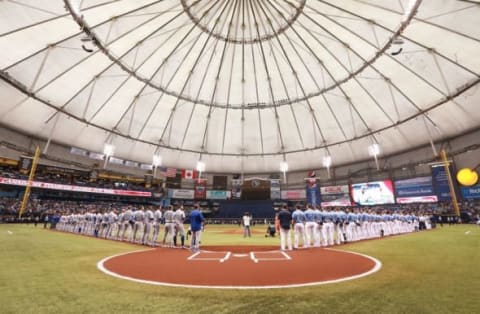
Despite not having a long history, the Tampa Bay Rays have had a number of stellar players come through the organization. Who would make up their all time 25 man roster?
Tampa Bay had long been the destination for teams threatening to relocate. As teams looked to get more and more money from their local governments for new ballparks, Tampa Bay became quite the hotbed of baseball rumors. In fact, the San Francisco Giants almost moved to Florida before AT&T Park was built.
Finally, on March 9, 1995, the Tampa Bay Rays came into existence. An ownership group fronted by Vince Naimoli was selected as one of two groups to receive an expansion franchise. Finally, regular season Major League Baseball would come to the Tampa-St. Petersburg area.
It took a decade for the Rays to find success. During that time, they finished outside of the cellar only once, with a fourth place finish in the American League East in 2004. However, beginning in 2008, when the Rays went on a surprise run to the World Series, they became contenders. Right into the middle of the current decade, the Rays were a formidable squad, and one that could defeat any team in baseball.
Recent years have not been as kind to the franchise. After four playoff appearances from 2008 through 2013, the Rays have struggled once more. Handicapped by payroll issues, and an obsolete stadium, it has gotten more difficult for the Rays to recapture their former glory. However, even though the front office and manager have changed, that does not mean the future of the franchise is dark.
While the Rays may have only come into existence less than a decade ago, quite a few stellar players have passed through their clubhouse doors. And so, let us take a trip down memory lane, and look at the Tampa Bay Rays all time 25 man roster.
Catcher: Toby Hall (2000-2006)
The catching position has been a black hole for the Tampa Bay Rays throughout franchise history. It has been a revolving door, and one that has not exactly seen the best come through.
That is not to say that there have not been decent performances from any Rays backstop. Toby Hall, the longest tenured catcher in Rays history, had some solid years. He hit twelve home runs in 2003, and had three consecutive years with 20 or more doubles.
Overall in a Rays uniform, Hall produced a .262/.298/.382 batting line with 44 home runs and 122 doubles. A solid contact hitter, Hall rarely struck out, going down by strikes in only 8.6% of his career plate appearances. However, he also barely walked, with only 4.1% of his plate appearances ending in a free pass. His high contact, low power bat resulted in a below average hitter, but he was still easily the best that the Rays had seen.
Defensively, Hall was a solid catcher. Even though he led the league in errors twice, he was still worth ten runs saved in Tampa Bay. In 2005, despite leading the league with nine errors, Hall still led the American League with a 2.9 defensive WAR. He was in the top five in caught stealing percentage on three occasions, and was an above average catcher for most of his career.
The Tampa Bay Rays may not have a proud history behind the plate, but Toby Hall was a solid player. He was certainly head and shoulder above everything else that has been there in franchise history.
First Base: Carlos Pena (2007-2010, 2012)
If not for an injury to Greg Norton, Carlos Pena may have never had the chance to become the best first baseman in Tampa Bay Rays history.
After spending most of the 2006 season in the minors, Pena had been signed by the Rays to a minor league contract. However, on the last day of Spring Training, Norton injured his knee, requiring surgery. Pena was called up to the active roster, and after a slow start, began to hit. That set the stage for his first four seasons with the Rays, where he became a key part of their lineup. He would hit a career high 46 homers that season, the first of three consecutive years with 30 or more home runs.
Pena received plenty of recognition during that time. He won a Silver Slugger Award and made the 2009 All Star Game. Twice, he finished ninth in the MVP balloting. While his second time in a Rays uniform was not as successful, Pena still established himself as one of the better players in team history. Overall, he had a .230/.360/.483 batting line, hitting 163 home runs.
But Pena was more than just a power threat. He was also a key part of the Rays focus on defense, saving the infielders countless errors. He won a Gold Glove for his efforts in 2008, the year that the Rays made the World Series. In fact, that glove was a part of the reason he was brought back in 2012.
Carlos Pena was a lot more than a one dimensional slugger. His glove at first base, and his ability to hit for power, helped lift Tampa Bay out of the cellar.
Second Base: Ben Zobrist (2006-2014)
Considered a minor prospect in the Aubrey Huff trade, Ben Zobrist became a key part of the Rays success.
A solid all around player, Zobrist had an excellent blend of power and speed. While he may not have dazzled in any one area, he hit 20 or more home runs three times, and stole double digit bases on five occasions. A two time All Star, Zobrist finished as high as eighth in the MVP ballot.
During his nine seasons with the Rays, Zobrist had a solid .264/.354/.429 batting line, hitting 114 home runs, 229 doubles, and stealing 102 bases. He was also an excellent at bat, taking pitches and working the count to his advantage. It has certainly worked, as Zobrist consistently produces an above average walk rate and a below average strikeout percentage.
His true value comes from his versatility. While he spent most of his time at second for the Rays, he also spent time in right, left, and short. In fact, during his tenure with the Rays, he played everywhere except catcher and pitcher. No matter where he was slotted, he performed well, saving 48 runs at second and over 30 runs in the outfield.
A true utility player that could be slotted anywhere on the field, Ben Zobrist helped change the way utility players were regarded. A versatile player with a bat that could play anywhere, Zobrist made his mark not only on the Rays, but in baseball as a whole.
Shortstop: Julio Lugo (2003-2006)
Julio Lugo spent parts of four seasons with the Tampa Bay Rays, but still ranks as the team leader in virtually every category at short.
Acquired as a free agent following continual legal issues, Lugo found a home in Tampa Bay. His ability to make contact and steal a base became quickly apparent, as Lugo stole double digit bases in each of his four years with the Rays. He also possessed surprising power, hitting double digit home runs twice.
With his ability to get on base, and his gap power leading to doubles, Lugo was a solid presence in the Rays lineup. He had a .287/.350/.421 batting line, hitting 40 home runs and 107 doubles while stealing 88 bases. Another player who excelled at making contact, Lugo struck out in only 14.6% of his plate appearances with Tampa Bay.
Lugo was also a bit underrated defensively. He was also considered 17 runs above average during that time, and was better than average in regards to range factor and fielding percentage. Twice, Lugo led the American League in range factor per game at short, and he was in the top five in runs saved twice.
He may have been remembered as a relatively light hitting shortstop, but Julio Lugo was more than that. He was a solid sparkplug towards the bottom of the lineup, and a solid defensive presence.
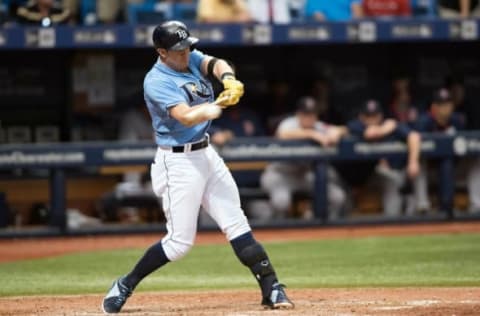
Third Base: Evan Longoria (2008-present)
Seemingly every great player to come through the Tampa Bay Rays clubhouse has left. That is, aside from Evan Longoria, the face of the franchise.
Signed to a long term extension after just six Major League games, Longoria signed another extension that will keep him with the Rays for the rest of his career. It is certainly understandable as to why they would keep him, as Longoria has cemented his place as the greatest player in franchise history thus far.
A three time All Star and the 2008 Rookie of the Year, Longoria is the franchise leader in virtually every category. He has a career .271/.344/.490 batting line with 241 homers and 302 doubles. Longoria even flashed some speed earlier in his career, stealing 15 bases in 2010, when he finished sixth in the MVP balloting.
Longoria has also shined defensively. The 2009 Gold Glove winner, he has been worth 87 runs saved, the 14th best mark in MLB history. One of the better defensive third basemen in the game, one could argue that he deserves more than that one Gold Glove, given his ability to make the difficult plays seem routine.
At only 31 years old, Longoria still has a few prime years left. If he can continue to produce through the end of his contract in 2022, he may well be the first true member of the Rays to receive serious consideration for Cooperstown.
Right Field: Matt Joyce (2009-2014)
One of the young players that came up at almost the same time, Matt Joyce was a key part of the Tampa Bay Rays surge up the standings.
A solid power hitter, Joyce was one of the key pieces of the Rays lineup during the early part of the decade. He hit double digit home runs in four consecutive seasons, topping out with 19 homers in 2011. That year, he made his only All Star Game, setting career highs in virtually every area.
Known for his ability to hit righties, Joyce was a good player for the Rays. Overall, he produced a .250/.342/.435 batting line in Tampa Bay, hitting 76 home runs and 111 doubles. Although he struck out at an above average rate, Joyce also had a solid batting eye, drawing a walk in 11,9% of his plate appearances.
Capable of playing both corner outfield positions, Joyce proved to be a decent fielder. While he was not Gold Glove caliber, he was about average in the field. He also possessed a strong arm, notching eight outfield assists in 2011, and being a part of three double plays.
A free agent who had been coveted for his ability to hit righties, Matt Joyce will spend the next two years in Oakland. However, he made his mark on the Rays, who gave him his first real chance to be an every day player.
Center Field: Melvin Upton (2004, 2006-2012)
The Tampa Bay Rays, in drafting early throughout their first decade, found a number of interesting athletes in the beginning of the draft. Melvin Upton was one of those players, taken with the second overall pick in 2002.
He made his debut two years later, but did not stay in the Majors until 2006. From that point, he showed an intriguing blend of power and speed, hitting 20 or more homers three times, while stealing 30 or more bases in five consecutive seasons. He was one of the dynamic pieces that the Rays were looking for as they began to craft a contending franchise.
He certainly established himself as a star with Tampa Bay. In his time with the Rays, Upton produced a solid .255/.336/.422 batting line, hitting 118 home runs and stealing 232 bases. And yet, it always seemed as though there should have been more from Upton, as his proclivity to strike out hampered his production.
While Upton had the potential to excite on offense, he was a stellar defensive player. Despite playing at short and third until 2007, he quickly found a home in center. During those five years, he saved 49 runs while leading center fielders in assists and double plays twice. Yet, Upton never won a Gold Glove for his work in the outfield.
At a time when the Rays did not give the fanbase many reasons to tune in, Melvin Upton was one of the few bright spots. His blend of power, speed, and defense set the stage for what the Rays Way would become.
Left Field: Carl Crawford (2002-2010)
If ever there was a player that was built for the Tampa Bay Rays, it may have been Carl Crawford.
A star with Tampa Bay, his fortunes changed the moment he left Tropicana Field. He had become a star, noted for his speed and solid power. Crawford was a four time All Star with the Rays, and led the American League in triples and steals four times. He also had double digit homers six times, showing that he was more than just a speedster with the ability to put the ball into the gap.
Crawford finished seventh in the 2010 MVP vote, but he was extremely valuable to the Rays. Overall, he posted a .296/.337/.444 batting line, hitting 104 homers, 105 triples, and stealing 293 bases. He was particularly effective against the Boston Red Sox, to the point where they offered him a Godfather contract to sign after the 2010 season.
The 2010 Gold Glove winner, Crawford was also a brilliant defensive left fielder. He was worth 68 runs saved in his time in Tampa Bay, and led the league in range factor five times. His excellent speed helped him to be a four time leader in putouts in left, showing that he deserved more than the one Gold Glove award.
Carl Crawford was the perfect player for the Tampa Bay Rays. One of their first truly home grown stars, he was a key to their success in the latter part of the 2000’s.
Designated Hitter: Greg Vaughn (2000-2002)
The Tampa Bay Rays may have gotten Greg Vaughn towards the tail end of his career, but he was still a legitimate power threat in their lineup.
While his best days were behind him at that point, Vaughn was still a player to account for in the lineup. He made the All Star Game in 2001, and hit over 20 home runs twice. Vaughn also still had a solid batting eye, drawing over 70 walks in his first two seasons. He even chipped in 11 steals in that 2001 season.
Although he was not the same player that hit 50 homers in 1998, Vaughn still put together a solid performance with the Rays. His .226/.335/.434 batting line was skewed by a horrific 2002 campaign, where he struggled to find his groove at the plate. Nonetheless, he still hit 60 home runs, and showed surprising speed with 22 steals.
Despite not having a reputation as a good defensive player, Vaughn proved to be surprisingly adept in the outfield. He saved seven runs defensively, while showing surprising range and a good arm. In his three seasons, Vaughn notched 12 outfield assists, turning three double plays.
Greg Vaughn was the typical Rays signing at the time, a veteran free agent slugger who was at the end of his career. However, he still had a bit of life left in his bat, showing flashes of the power that made him desirable on the open market.
Backup catcher: John Flaherty (1998-2002)
Only three catchers in Tampa Bay Rays history reached the 1000 plate appearance mark. Even without that threshold, John Flaherty may have been the best defensive catcher in team history.
Traded to the Rays on November 17, 1997, Flaherty found himself thrust into a starting role. Although he struggled in his first season with the Rays, his production increased the following season. Twice, Flaherty hit double digit home runs, providing decent production behind the plate.
Overall, in his five seasons with the Rays, Flaherty had a .252/.289/.365 batting line, hitting 82 doubles and 35 home runs. While those numbers may not seem overly impressive. Flaherty ranks second in Rays history in most offensive categories.
Where Flaherty shined was defensively. He was worth nine runs saved during his time in Tampa Bay, while showing a solid arm. He led the American League with 52 baserunners caught stealing in 1999, and was in the top four in double plays turned as a catcher three times. His 11 runs saved in 1999 ranked second, as he deserved strong consideration for a Gold Glove that year.
John Flaherty was a solid catcher with a little pop who shined defensively. He would set the mold for what would be a typical Rays catcher throughout franchise history.
Corner infielder: Aubrey Huff (2000-2006)
A consistent power hitter, Aubrey Huff was a mainstay in the middle of the Rays lineup in the early part of the 21st century.
While he never made an All Star Game, and only received MVP votes once during his time in Tampa Bay, he was still a solid player. Huff hit 20 or more homer runs in five consecutive seasons, and hit 20 or more doubles six times. His 2003 season was the best of his career, as he produced a .311/.367/.555 batting line with 34 homers, 47 doubles, and 107 RBI.
During his six and a half years with the Rays, Huff was an offensive force. He produced a .287/.343/.477 batting line, hitting 128 home runs and 172 doubles. Another excellent contact hitter, Huff struck out only 412 times in 3322 plate appearances, while drawing 247 walks.
Primarily a third baseman in Tampa Bay, Huff eventually moved to first base and the outfield after leaving the Rays. He did begin to shift positions before being traded to Houston, making him a useful utility player in his own right. Although he had his moments in the field, Huff was generally below average defensively, but that flexibility allowed the Rays to keep his bat in the lineup.
Aubrey Huff continued to contribute to the Tampa Bay Rays even after his trade, as he was the player moved for Ben Zobrist. His contributions with the team lasted longer than his career, but his ability with the bat still withstands the test of time.
Middle Infield: Akinori Iwamura (2007-2009)
Injuries limited Akinori Iwamura to only two and a half seasons with the Tampa Bay Rays, but he made the most of the opportunity that he had.
Signed after being posted by the Yakult Swallows, Iwamura made an immediate impression stateside. He was second in the Rookie of the Month voting in April 2007, and continued his strong play throughout the season. His ability to hit triples became otable, as he finished in the top three in the category in his first two seasons.
Even though he never showed the power he displayed in Japan, Iwamura was a solid second baseman for Tampa Bay. In his time with the Rays, he produced a .281/.354/.393 batting line, hitting 21 triples and 67 doubles. Interestingly, he did not show much speed onthe basepaths, with only 29 steals in his two and a half years.
Iwamura split his time between second and third, showing roughly average ability at each position. He was fifth in putouts and assists at second in 2008, after making the transition from third. The previous year, he led American League third baseman with a .975 fielding percentage, but was moved from the position for Evan Longoria.
A torn ligament in his knee, suffered in a collision with baserunner Chris Coghlan, ended his time in Tampa Bay, and effectively ended his Major League career. He headed back to Japan after 2010, but continued to struggle, eventually retiring after the 2014 season.
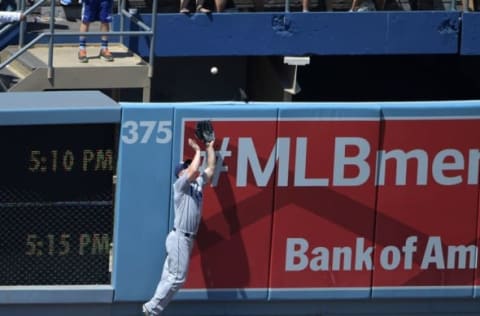
Outfield: Kevin Kiermaier (2013-present)
It did not take long for Kevin Kiermaier to make an impression with Tampa Bay Rays fans.
After getting into one game in 2013, Kiermaier found himself as part of the Rays 2014 lineup, and instantly asserted himself as a human highlight reel. His ability to catch virtually anything in the outfield, while showing decent pop at the plate, led to the hope that he could be the next piece the team could build around. His double digit home run hitting, and his developing stolen base ability, shows the possible ceiling he could reach.
Kiermaier has already had a solid career in Tampa Bay. Although he is just about to enter his fourth season, he has already established himself as one of the better outfielders in team history. In that time, he has produced a .258/.313/.425 batting line, hitting 32 homers and stealing 44 bases. His speed and power numbers have increased each season, giving the Rays hope that he can breakout offensively.
On defense, Kiermaier is already a star. He has established himself as a daily Web Gem, making the extraordinary seem routine. A two time Gold Glove winner, he has already saved 36 runs in center, leading the league in each of the past two years. Possessing a strong arm and incredible instincts, Kiermaier has been amongst the leaders in range factor and assists in each of the past two seasons.
The sky appears to be the limit for Kevin Kiermaier. A defensive star with a developing offensive game, the past three years are only just the beginning.
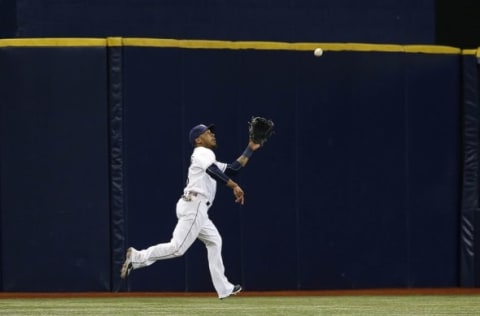
Outfield: Desmond Jennings (2010-2016)
Desmond Jennings was expected to be the next Carl Crawford. Although he never reached his full potential, he was still quite the productive player for the Tampa Bay Rays.
Expected to be another power and speed threat, Jennings was never quite that player. He did have four seasons with double digit home runs, and three seasons where he stole 20 or more bases, but he never put everything together. Nonetheless, Jennings was a solid player, and one that showed flashes of that potential the Rays hoped for.
During his time in Tampa Bay, Jennings posted a .245/.322/.393 batting line, hitting 55 home runs and stealing 95 bases. Those numbers were solid enough, but his fragile health left Jennings unable to become Crawford 2.0 as the Rays had hoped for.
Even if he disappointed at the plate, Jennings was a stellar outfielder. Although he spent most of his time in left, he did appear in center and right as well. However, left field was where he was comfortable, as he saved 18 runs in left. His excellence with the glove resulted in two seasons with a perfect fielding percentage, helping Jennings rank sixth all time in that category.
Desmond Jennings may not have been the player the Rays expected him to be, but he was still a solid enough outfielder.
Now, let us move on to the pitching staff.
Starting Pitcher: James Shields (2006-2012)
James Shields became a solid middle of the rotation starter for the Rays, eventually becoming a true top of the rotation starter towards the end of his tenure in Tampa Bay.
Shields quickly established himself as one of the premier innings eaters in the game, with 200 innings or more in six seasons. However, it was not until 2011 until he truly established himself as an ace, posting a 2.82 ERA while leading the American League with 11 complete games and four shutouts. He made his only All Star Game that year, while finishing third in the Cy Young vote.
That turnaround coincided with an uptick in strikeouts. For the first time in his career, Shields struck out over 200 batters in a season in 2011, and followed that up by doing so once again the following season. He also cut down on his home run rate, from 1.5 home runs per nine innings in 2010 to 0.9 in 2011.
The Rays all time leader in wins and innings, Shields posted an 87-73 record with a 3.89 ERA and a 1.223 WHiP. In his 1454.2 innings, he struck out 1250 batters while issuing only 340 walks. His regular season success did not translate to the postseason however, as he allowed 20 runs, 19 earned, in 34.1 postseason innings with the Rays.
James Shields may have struggled this past season, but he was one of the best pitchers in Tampa Bay Rays history. At 35 years old, his best days may be behind him, but his time in Tampa Bay will not be forgotten.
Starting Pitcher: David Price (2008-2014)
David Price first made his mark during the Tampa Bay Rays run to the World Series as a September callup in 2008, and quickly became one of the best pitchers in baseball.
The 2012 Cy Young winner, Price led the American League with 20 wins and a 2.56 ERA that year. It marked the third consecutive season that he made the All Star Game, and solidified his place as one of the top pitchers in the game. Overall, during his time in Tampa Bay, Price was a four time All Star, and finished in the top two of the Cy Young voting twice.
Price also established himself as a true workhorse, pitching over 200 innings in three consecutive years. Even with that workload, he dominated, finishing in the top ten in WHiP and strikeouts three times. In fact, the only knock on Price in a Rays uniform may be his postseason performance, as he failed to win a single game he started in the playoffs.
Nonetheless, Price was a key part in getting the Rays to October. He posted an 82-47 record with a 3.18 ERA and a 1.1142 WHiP. In 1143.2 innings, Price struck out 1065 batters, issuing only 309 walks. Price was also adept at keeping the ball in the yard, allowing less than a home run per nine innings.
Probably the most dominant starting pitcher in the history of the Tampa Bay Rays, David Price was one of the best in baseball during his time under the dome.
Starting Pitcher: Scott Kazmir (2004-2009)
Scott Kazmir was part of one of the more lopsided trades in baseball history, acquired by the Tampa Bay Rays from the New York Mets for Victor Zambrano.
A top prospect, Kazmir quickly established himself atop the Rays rotation. He made his debut at age 20 in 2004, and two years later, made his first All Star Game. Kazmir led the American League with 34 starts and 239 strikeouts in 2007, and made his second All Star Game in 2008.
With his his octane fastball, Kazmir ranked in the top ten in strikeouts three times, and finished in the top three in strikeouts per nine innings twice. He also struggled with his command at times, leading the league with 100 walks in 2005, while hovering close to four walks per nine innings throughout his time in Tampa Bay.
During his five and a half years with the Rays, Kazmir posted a 55-44 record with a 3.92 ERA and a 1.390 WHiP. He struck out 874 batters in 834 innings, although his 382 walks limited his effectiveness at times. Yet, despite those control issues, Kazmir was still quite the stellar pitcher for the Rays.
Alas, that workload caught up with him after he departed Tampa Bay, leading to Kazmir temporarily being out of baseball in 2012. However, he has resurrected his career, pitching relatively well when he has been healthy.
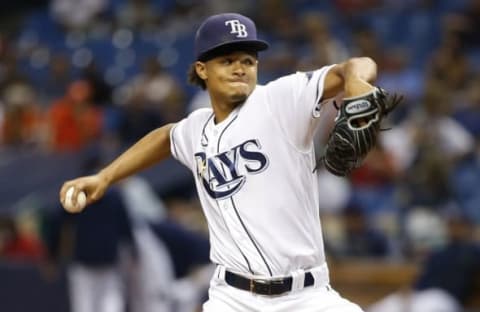
Starting Pitcher: Chris Archer (2012-current)
Chris Archer appeared to be on the verge of being the next star for the Tampa Bay Rays, but took a step backwards last year.
Prior to that point, Archer had displayed steady progress towards a 2015 campaign that appeared to be his breakout campaign. His 12-13 record was misleading, as Archer posted a 3.23 ERA and a 1.137 WHiP. He led the American League with 34 starts, and in his 212 innings, struck out 252 batters while issuing only 66 walks.
Last year, Archer’s season looked like a disaster. He led the league with 19 losses, posting a 4.02 ERA. However, he still struck out 233 batters in 201.1 innings, issuing only 67 walks. Archer also had a 1.242 WHiP and a 3.81 FIP. Likewise, the Rays somewhat underwhelming offense did not do him any favors.
Overall with the Rays, Archer has posted a deceiving 41-51 record, to go along with a 3.51 ERA and a 1.202 WHiP. In his 766 innings, Archer has struck out 795 batters, issuing 256 walks. With the departure of David Price, Archer has established himself as the Rays ace, and one of the better pitchers in the league, despite his record.
The Tampa Bay Rays need Chris Archer to continue his strong performance if they hope to contend this season. If that happens, he could find his way higher on this list.
Starting Pitcher: Matt Garza (2008-2010)
Matt Garza only spent three seasons with the Tampa Bay Rays, but he certainly made an impact.
Acquired along with Jason Bartlett in the trade that sent Delmon Young to the Twins, Garza was a key piece of the Rays surprising World Series run in 2008. That year, he led the American League in shutouts, and was named the MVP of the American League Championship Series when he was 2-0 with a 1.38 ERA as the Rays got past the Red Sox in seven games.
Garza also found his way into the Rays history books in 2010. On July 26, he threw the first, and thus far only, no hitter in Rays history. In facing the Detroit Tigers, he allowed only one baserunner, walking Brennan Boesch in the second inning. Garza then got Ryan Raburn to ground into a double play, as he faced the minimum 27 batters in his gem.
With his tenure coinciding with the Rays success, Garza found his three best seasons in Tampa Bay. In that time, he posted a 34-31 record with a 3.86 ERA and a 1.251 WHiP. In 592.1 innings, he struck out 467 batters, while issuing 201 walks. His evolution from former prospect to a key part of the Rays rotation helped make their success possible.
Matt Garza was another player who continued to contribute to the Tampa Bay Rays even after his tenure came to an end. Traded to the Chicago Cubs following the 2010 season, he helped bring over Chris Archer, the current ace of the staff. Even now, his presence can be felt in Tampa Bay.
And now, on to the bullpen.
Closer: Fernando Rodney (2012-2013)
Almost improbably, Fernando Rodney put together one of the greatest seasons in baseball history, and the best season of any pitcher with 50 or more innings before Zack Britton in 2016.
Plucked off the scrap heap for what turned out to be a two year contract worth $4.25 Million, Rodney immediately paid dividends when the projected closer, Kyle Farnsworth, started the season on the disabled list. Joel Peralta, who seemed to be the next person in line, struggled, opening the door for Rodney to have another chance to close.
He took off with that chance, earning his first All Star Game nod and finishing fifth in the Cy Young vote. That year, Rodney notched 48 saves with an incredible 0.60 ERA and a 0.777 WHiP. He ended the season with 19 consecutive scoreless innings, earning the Comeback Player of the Year award for 2012.
While his following season was not at the same level, Rodney established himself as the most dominant closer in Rays history. In those two seasons, he recorded 85 saves with a 1.91 ERA and a 1.040 WHiP. Over 141.1 innings, he struck out 158 batters, issuing only 51 walks as the Rays got his command issues under control.
As a smaller market team, the Tampa Bay Rays have often needed to search the scrap heap for a diamond in the rough. Fernando Rodney may have been the best example of that strategy working out.
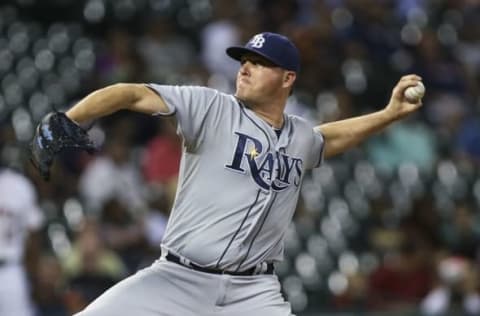
Setup Man: Jake McGee (2010-2015)
For a time, it seemed as though Jake McGee was the closer in waiting for the Rays. However, he never quite had the chance to seize the job for his own.
A former top prospect, McGee was rated as the 15th best prospect in baseball by Baseball America prior to the 2008 season. Primarily a starter in the minors, McGee converted to a relief role in 2010, joining the Rays as a September callup. He remained int he bullpen from that point, serving initially as a middle reliever before becoming a solid setup man and a possible closer in the future.
McGee finally had a chance to close in 2014 when Grant Balfour struggled. He did well, notching 19 saves and continuing to strike out over a batter an inning, seemingly solidifying himself in the role for 2015. However, he missed the start of the season due to elbow surgery, and struggled through an injury plagued year before undergoing season ending surgery on his left knee.
Even with those health issues, and his missed chance to become the Rays closer, he was still the top reliever in team history. Leading all Rays relievers with a 6.2 WAR, McGee posted a 2.77 ERA and a 1.017 WHiP, striking out 319 batters in 259.2 innings. He did record 26 saves with the Rays, to go along with 84 holds in his five plus years in Tampa Bay.
Maybe Jake McGee never became the closer that the Rays expected. Even then, he was, by at least one metric, the best reliever in team history.
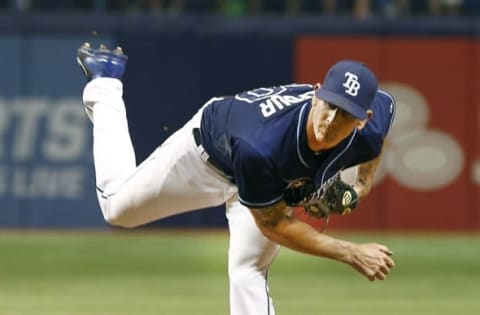
Reliever: Grant Balfour (2007-2010, 2014-2015)
Grant Balfour was one of the key reasons as to why the Tampa Bay Rays bullpen had their extraordinary turnaround in 2008, coinciding with their run of success.
However, Balfour’s tenure with the Rays did not start out well. He had a 6.14 ERA and a 1.909 WHiP in 2007 after being acquired from the Brewers, hardly numbers that would inspire confidence. However, he dominated in 2008, posting a 1.54 ERA and a 0.891 WHiP, as he became a key piece in the bullpen.
After spending three years as the A’s closer, Balfour returned to Tampa Bay, set to become their closer. This came after his deal with the Orioles was voided due to medical issues found during a physical, allowing the Rays to sign him to a lesser contract. Instead of continuing to dominate, Balfour struggled with his command, failing to hold to closer role, and being released the following year.
Although his time in Tampa Bay did not end in the way anyone would have wanted, Balfour still had a solid career with the Rays. He posted a 3.74 ERA and a 1.272 WHiP, recording 61 holds and 20 saves. In his 269.2 innings, Balfour struck out 291 batters. His lack of control did cause issues, as Balfour also allowed 135 walks.
One of just 30 Australians in Major League history, Grant Balfour was a solid pitcher for the Rays. His command issues, and possibly an injury, made his return bittersweet.
Reliever: Roberto Hernandez (1998-2000)
One of the Rays first free agent signings, Roberto Hernandez was a solid closer on some truly awful teams.
Hernandez had been a solid closer with the White Sox, and brought that experience to the expansion Rays. While he struggled in his first season, Hernandez rebounded to become an All Star in 1999, joining Jose Canseco to give the Rays their only year with more than a token player in the Midsummer Classic until 2008.
In his three seasons in Tampa Bay, Hernandez was in the top five in games finished all three years, leading the league with 66 in 1999. He finished in the top ten in saves twice, including a second place finish with 43 saves during that All Star season.
Despite being the Rays first closer, Hernandez is still prominently in their record books. The all time leader with 101 saves, he posted a 3.43 ERA and a 1.358 WHiP, striking out 185 batters in 218 innings. Even if he was not the flamethrowing strikeout machine that we so often expect from closers these days, he was still effective in his role.
In most cases, the first closer in team history will not be the one staying atop the record books for years to come. Right now, Roberto Hernandez has defied those odds.
Reliever: Joel Peralta (2011-2014)
The Tampa Bay Rays have had a very good run in recent years of finding solid setup men and being able to piece together a strong bullpen. Joel Peralta was another one of those pieces.
Peralta’s story is one of perseverance. He did not reach the Majors until he was 29 years old, and split the 2009 and 2010 seasons between the Majors and the minors. The Rays picked him up for $900,000 prior to the 2011 season, and he turned out to be quite the bargain in the bullpen.
A durable arm, Peralta led the American League with 80 appearances in 2013, and despite an illness that sidelined him for a month in 2014, never appeared in fewer than 69 games in a season. That 2014 campaign was the only one of his years in Tampa Bay where he did not rank in the top two in appearances, as Peralta proved to be a dependable option for the Rays.
During his tenure in Tampa Bay, Peralta posted a 3.58 ERA and a 1.054 WHiP, recording 115 holds and striking out 293 batters in 269.1 innings. He displayed tremendous command, issuing only 84 walks in that time. In fact, the only real problem that Peralta faced was his tendency to give up the home run, as he gave up 32 homers with the Rays.
Joel Peralta was yet another of the many scrap heap free agents that the Tampa Bay Rays have signed over the years. He did quite a wonderful job during his time in Tampa Bay.
Long Reliever: Jeff Niemann (2008-2012)
It has been seemingly forever since Jeff Niemann has been on a baseball diamond due to his shoulder issues, but the Tampa Bay Rays pitcher has not retired just yet.
More from Call to the Pen
- Philadelphia Phillies, ready for a stretch run, bomb St. Louis Cardinals
- Philadelphia Phillies: The 4 players on the franchise’s Mount Rushmore
- Boston Red Sox fans should be upset over Mookie Betts’ comment
- Analyzing the Boston Red Sox trade for Dave Henderson and Spike Owen
- 2023 MLB postseason likely to have a strange look without Yankees, Red Sox, Cardinals
His career showed a good amount of promise. In 2009, he became a part of the Rays rotation, finishing fourth in the Rookie of the Year balloting, and began a run of three consecutive years with double digit wins. His 2011 campaign was the best of his young career, as he set personal bests in WHiP, strikeouts per nine innings, and walks per nine innings.
Unfortunately, the 2012 season was a disaster due to injuries. He missed significant time due to a broken leg after being hit by a comebacker off the bat of Adam Lind. Then, later in the year, he had shoulder problems, undergoing surgery for a debridement of rotator cuff and labrum in 2013, a procedure he failed to return from. However, Niemann is not listed as retired, as he is apparently holding out hope that he can come back at some point.
Overall, Niemann had a solid tenure with the Rays. He posted a 40-26 record with a 4.08 ERA, falling just about average for his time in the Majors. Niemann also had a 1.286 WHiP while striking out 409 batters in 544.1 innings of work. He was a solid pitcher, who showed the potential to be even better before his shoulder gave out.
Next: Rangers all time 25 man roster
Maybe Jeff Niemann can return at some point in time, giving his story a better ending. However, with the time tha thas passed, it seems highly unlikely.